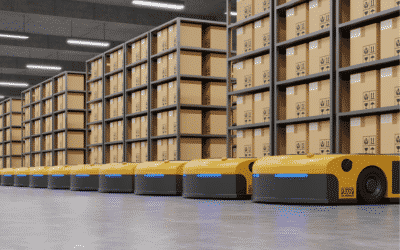Due to complex supply chains, very large product ranges and low margins, retail is arguably one of the most competitive industries around. Both traditional brick-and-mortar shops and e-commerce providers are experiencing cut-throat competition. The only way to stay ahead is to continuously optimise assortments and improve business processes.
One of the key factors retailers can control to differentiate themselves from their competitors is their product assortment. With the help of advanced analytics and AI, retailers can make better decisions about which products to sell in their locations and adapt assortments to local customer preferences and different shop sizes.
Inhaltsverzeichnis
Our approach to assortment optimisation in retail
Our approach is based on a five-step process:
- Quantifying the cross-selling effect between products
- The quantification of the similarity / uniqueness of products
- Understanding what factors of a product create increased demand
- Forecasting product demand
- The optimisation of the assortment
Quantifying the cross-selling effect between products
We start with an example
Super-fresh, a North American supermarket chain owned by grocery retailer A&P, delisted many of its low-selling dry goods to expand its fresh produce offering. However, the delisted products turned out to be indispensable to customers. So when they could no longer find these products, they shopped elsewhere, which had a major impact on the company's performance - even leading to bankruptcy.
Until now, purchasing managers have been guided by simple performance indicators such as sales or rotation figures, combined with their many years of experience in the profession, to decide whether they should add a new product to the range or discontinue a poorly selling product.
However, these offer simple key figures no longer provide enough informationto decide whether a product should be discontinued. Looking at the performance of a product in isolation does not take into account the cross-selling effect that products have on each other.
Assortment optimisation in retail with AI and Advanced Analytics has been increasingly used for some years now to improve the Better understand client behaviour and quantify the cross-selling effect between products. This is usually done by analysing all historical purchase transactions originating from point of sale (POS) systems and determining the co-occurrence of product pairs.
It is important for retailers to understand what happens when a customer does not find the product he is looking for. Will he choose another, similar product? Or will he shop somewhere else altogether?
Quantification of similarity & uniqueness
Even if some products do not have outstanding performance figures in themselves, they can be key factors in bringing customers into the shop motivated by the search for these unique products. On the other hand, there are products that customers can easily replace with similar products. This is the so-called "cannibalisation effect" between products that occurs when customers do not have a clear preference between two similar products.
Retailers can use assortment optimisation with AI and advanced analytics to quantify the cannibalisation effect between products and their uniqueness to optimise their listing and delisting process.
The uniqueness of products is calculated by taking the Cross-selling relationship between products analysed becomes. For example, products are similar if they are in similar baskets. For example, milk A and milk B would be considered similar if the products typically purchased with them are also similar. Using a similarity score between all products in the range, retailers can determine the uniqueness of a product by how many similar products are in the range.
What product factors are driving increased demand?
New products present another difficult challenge because there is no historical sales data on which to base a reliable forecast to estimate the sales performance of the product. This is the so-called "cold start" problem.
The assortment optimisation with KI and Advanced Analytics also helps retailers solve this challenge. Retailers have big data to help them understand which product attributes are most important to customers and what their customers will do if they don't find their preferred products.
Demand forecasting
Through AI tools, modern retailers can now assess product demand to select the most promising products based on shop characteristics. This Demand forecasts are also made taking into account the entire assortment and the interrelationships between the products. This captures the uniqueness of the products and the cannibalisation effects that occur when a new product is added to the range, as some of the product's demand is transferred when a new, similar product is listed.
Assortment optimisation with AI is the future
Optimising the assortment is a continuous process that is never quite finished. Therefore, it is important that retailers develop a culture to use advanced analytics in decision making in the long term.
To decide whether a particular product should be added to or removed from the range, an analysis is carried out across several dimensions.
- The economic performance of the product
- The uniqueness, cross-selling and cannibalisation effects between products
- Supply chain considerations
- Strategic goals
Discontinuing products reduces assortment complexity and improves margins. However, most discontinuations are motivated by the introduction of new products, as shop space is limited.
A shop's assortment must be seen as an evolving entity that should continuously adapt to new products and customer preferences, taking into account supply chain costs and alignment with broader strategic goals. These strategic goals could be, for example, a higher proportion of organic products or more gluten-free products in the assortment.
From coarse to fine
The assortment optimisation process is a multi-stage process that first takes place at the category level.
In a first step, the space per shop is divided by category by analysing its marginal contribution per metre and optimising it based on the trade-off between the different product categories.
The second step is intra-category optimisation, where an optimal balance between similar products and unique products is achieved. The goal of intra-category assortment optimisation is to find the best mix of similar and unique products so that shop sales are maximised, taking into account supply chains and strategic objectives.
The main concept of intra-category optimisation is that it does not make economic sense to have many similar products in the same category competing for limited shelf space. The space should better be allocated to products that have a higher "uniqueness" and cross-selling effect, thereby increasing the breadth of the assortment and at the same time increasing the Overlap between products reduced will.
Advantages of assortment optimisation in retail
Changes to the assortment have a major impact on the entire supply chain. Factors such as the cost of providing the product, where the end-to-end logistics costs are calculated, help determine optimal assortments that reduce the overall supply complexity and the Reduce costs.
Another important advantage of an optimised assortment is that it ensures an Optimum room layout according to branch characteristics and local customer preferences.
Using innovative forecasting methods, retailers can determine the optimal assortment for each shop, taking into account local store characteristics, and find out which factors affect the sales performance of the products. This allows retailers to select the products that best fit local characteristics, customer preferences, supply chain factors and strategic goals.
Conclusion
Getting the assortment right is critical for retailers. Optimised assortments lead to improvements in many areas of the business. Not only is turnover increased by a better product assortment, but also the reduced costs in the supply chain and thus higher product margins ultimately have a strong impact on the company's profit.
For a more in-depth introduction to what benefits AI brings to retail and e-commerce, check out our Retail Whitepaper. Here we explain the most important terms you need to know and present application areas as well as real use cases from our customer projects.










0 Kommentare